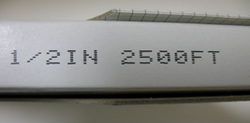WHITE PAPER: Basic Material Identification of
Legacy Tapes in An Archive
For preservation and inventory purposes it is essential to accurately and uniformly identify the materials in your collection. While different organizations use a wide variety of terms, the following is the essential information you need to describe your tapes:
1. Is the object tape or film?
If you can see images on it or it has sprockets along the edge, it is film.
If you can see images on it or it has sprockets along the edge, it is film.
If you cannot see through the material, it is tape.
Note: Some cassettes are described by tape width (e.g.: ¾" or 8mm), but since the tape is hidden by the shell, it cannot be easily measured and the width is essentially used as a “trade’ name.
3. Is the tape an audio or video recording?
Many tapes are used to record either audio or video. To distinguish the type of recording on a tape, you may have to examine the label or content information.
Many tapes are used to record either audio or video. To distinguish the type of recording on a tape, you may have to examine the label or content information.
4. Who manufactured it? What is the size?
Experts can often identify potential problems associated with specific manufacturers, and tape size can have an impact on processing costs.
Experts can often identify potential problems associated with specific manufacturers, and tape size can have an impact on processing costs.
5. Is the tape acetate or polyester?
Acetate and polyester perform and age differently. Common treatments for polyester tapes will destroy acetate tapes. Only open reel audio tapes may be made of acetate. No video tapes or cassettes are acetate.
Acetate and polyester perform and age differently. Common treatments for polyester tapes will destroy acetate tapes. Only open reel audio tapes may be made of acetate. No video tapes or cassettes are acetate.
6. Can you identify the content?
At a minimum, you should have the title, record date, and program running time.
At a minimum, you should have the title, record date, and program running time.










